How to Upload to Radio With Chirp
Information technology's not enough to just go a Ham radio and throw information technology in your bag. Function of actually having prepared comms for an emergency is knowing who you want to contact and how. You don't want to in-the-moment struggle to think and manually punch in 150.965 (a frequency) to accomplish your local emergency services, for example. Better to take that on speed dial.
Most radios, including models popular in prepping such every bit the BaoFeng UV5R and BF-F8, accept a built-in digital address book. But they're well-nigh as convenient as a 1990's VCR — it's a big pain to manually plan the settings via the keys on the radio.
CHIRP is complimentary Ham radio programming software that manages the radio's address book by plugging the radio into your computer. It'southward open source and works with the three major desktop operating systems (Windows, macOS, and Linux), just if you lot accept a choice, use Windows because it avoids some minor frustrations.
CHIRP works with near common radios. The total list is on their website.
All you lot need is an FTDI cable that works with your radio and a niggling chip of patience — it's wonderful that CHIRP exists, especially as gratis open-source software, but it's outdated and frustrating to use for people who want Ham in their preps merely don't want to "be a Ham."
New to Ham? Check out the beginner'southward guide to amateur radio and best handheld ham radios
This guide walks y'all through setting up and using CHIRP for common prep tasks like saving your personal contacts and importing local repeater, conditions, and first responder stations. We utilize common BaoFeng radios, but the steps are basically the aforementioned for any model and beyond computer operating systems.
Quick Choice
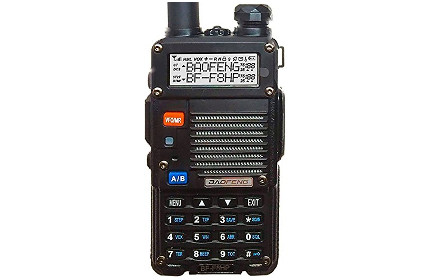
Popular entry-level:
BaoFeng BF-F8HP viii Watt Dual Band Handheld Ham Radio
One of the well-nigh popular handheld Ham radios because information technology's solid enough for most uses just under $100. 3rd generation of the previously popular UV-5R.
- Check price on Amazon
In this guide:
- Basic goals
- Get the correct cablevision
- Installing CHIRP
- General CHIRP tips
- 1st: Connect the radio and brand a backup
- Importing basic frequencies
- Calculation weather stations
- Adding local repeaters
- Calculation start responders
- Adding FRS and GRMS
- Changing full general radio settings
- Uploading changes to the radio
- Changing radio models in CHIRP
The goal: channels and settings, what to relieve, and backups
Common types of contacts you desire to have saved in your radio:
- Straight contacts similar family members, friends, coworkers, or your prepper grouping
- Local repeaters, which are special ham stations that rebroadcast messages over wider areas
- Atmospheric condition stations, similar the ever-on NOAA weather alerts
- Local first responders, such as police force, fire, and EMS
- FRS and GMRS frequencies, so you lot can talk with people on those style of radios (eg. common walkie-talkies)
Each specific matter you desire to contact has a frequency. Just instead of remembering 155.415 and who information technology matches to, you can simply give information technology a friendly saved proper name like "Fire Dept".
Each entry is saved in a aqueduct. The discussion is used for the same reason equally television channels, which, back in the solar day, were each associated to a frequency. Then instead of remembering that NBC was on 187.25, people simply needed to remember NBC = channel 4.
Saving your preferred frequencies in channels likewise makes it piece of cake to browse on your radio. Only hit the scan button and the radio volition continually cycle through your list of saved channels until it finds something with activity. That'south a core utilise-case yous volition use in an emergency.
CHIRP isn't merely for saving your accost book. You can hands create backups on your computer, deject storage, or USB drives. Y'all can share the same configuration file across everyone in your prepper group so they're on the same page. If you lose or upgrade your radio, boom, information technology's easy to reprogram.
Getting the correct radio-to-computer cable
Some radios like the Icom IC-7300 have USB ports, simply others don't, like the cheaper BaoFengs. In those cases, yous demand an FTDI cable that connects the radio's mic and speaker jacks to the USB port on your estimator.
There are many reports of errors with cheaper knockoff cables, so try to buy accurate cables from the manufacturer. The extra few dollars are worth it.
Our Option
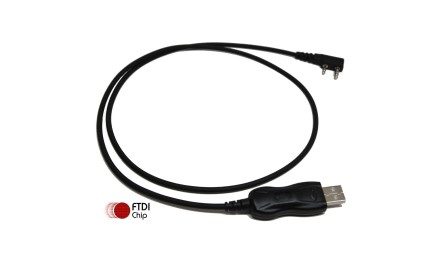
Essential product:
BaoFengTech Pc03 FTDI 18-carat USB Programming Cable
Utilize this cablevision to programme your BaoFeng UV-5R and BF-F8HP.
- Bank check Cost on Amazon
A common error is not seating the plugs all the way into the holes. You should experience an obvious click in one case the cable is fully engaged.
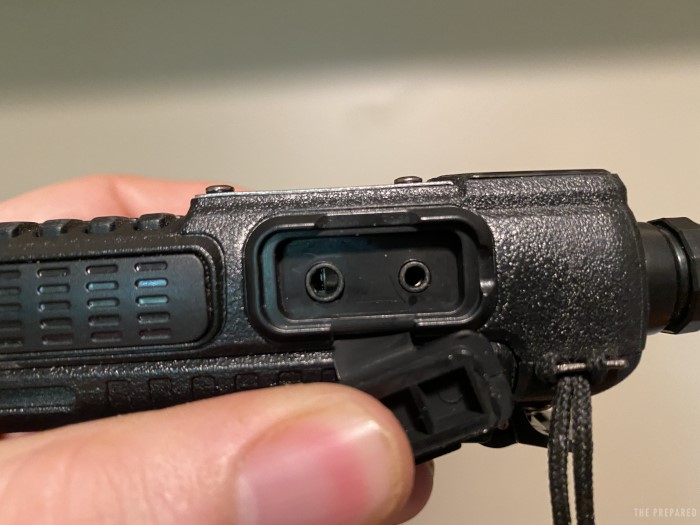
In that location's a chance your computer doesn't already have the capability to communicate with the cable. If that'southward the case, you'll demand to download and install a "driver" that lets the two talk to each other.
We haven't run across this driver trouble for a while though — this probably won't matter if you're on a modern computer. If your calculator has a hard fourth dimension recognizing your radio when it's connected to your computer, you might need to manually install a commuter from FTDI.
In our testing, the driver installed automatically in Windows x. The driver was already pre-installed on macOS and Arch Linux (Arch is a barebones Linux version, so it should also be pre-installed on more than-popular Linux distributions like Ubuntu and Fedora).
The FTDI driver provided by most operating system vendors volition not work with counterfeit fries. Often, when someone has a problem with CHIRP, a apocryphal cable is the cause.
How to install CHIRP
The installation and initial configuration tend to be some of the trickiest parts, then permit'southward take it step by step.
Windows
Download the Windows installer, open it, and click through the usual Windows prompts. In testing, nosotros found that CHIRP seems well-nigh at home on Windows.
Mac
CHIRP offers both legacy and unified packages for macOS just recommends the unified packet. (Green highlight, bottom of list.)
One time downloaded, you'll unzip the file, and so drag and drop the CHIRP application to your `/Applications/` folder.
The first time you launch it, you need to Control-click the app icon and cull Open. If you try to open information technology by double-clicking, you will receive an error since Apple hasn't given CHIRP its stamp of approval. (Don't worry, it'southward still rubber.)
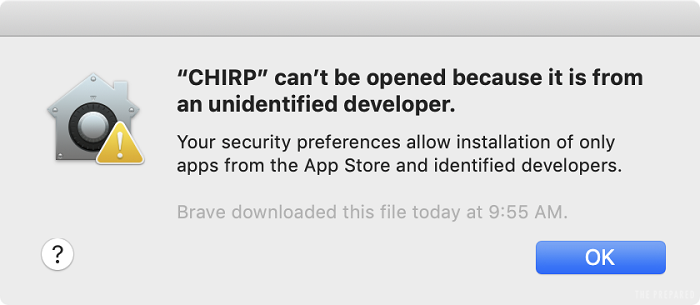
We've tested CHIRP on both macOS ten.14 Mojave and macOS 10.xv Catalina, and despite some warnings from the CHIRP developers, experienced no problem using CHIRP in Catalina.
Linux
CHIRP offers Linux installation packages for Ubuntu and Fedora, and a "tarball file" for other distributions. If you use an Arch Linux-based distribution, yous can install CHIRP from the Arch Linux User Repository.
Afterward installing CHIRP, y'all can launch information technology from the control line with the chirpw command. It may likewise show up in whatever plan launcher you lot apply.
The installation is straightforward enough, but you might get a permissions error. The developers propose adding your user to the dialout grouping with this command:
sudo usermod -aG dialout USERNAME
Where USERNAME is your name.
In testing with a ThinkPad running Curvation, CHIRP had a difficult time seeing the FTDI cable, which maps to /dev/ttyUSB0. Rebooting the ThinkPad with the cablevision inserted made it show up, and we haven't had whatsoever connection issues since.
Full general tips
You can practise almost of these tasks only on the computer without the radio plugged in or turned on. Of course, the radio needs to be connected and on when yous're moving data between the devices.
Any changes you brand on the reckoner don't change the radio until you specifically tell it to.
Loose cable connections and counterfeit cables crusade almost CHIRP problems.
The cable talks with the radio through audio tones. Then whenever doing this work, make sure your radio is tuned to a serenity frequency with no racket coming through (even with the volume at max). We propose removing the antenna from the radio before connecting information technology to your computer.
Nearly people desire to end up with an organized aqueduct listing, similar this very rough example:
- Ch 1-10 are for personal contacts
- xi-20 for repeaters
- 21-30 for weather condition stations
- 31-fifty for local services
- 51+ for FRS/GMRS
Information technology'due south helpful to go on some unused spaces. Imagine y'all start off with simply five personal contacts. Instead of starting the repeaters on Channel 6, you could leave 6-10 empty and offset the repeaters at Channel 11. That way, as you add more over time, you don't have to rework the whole organisation. This is all just personal preference, though.
But the software is clunky when it comes to keeping your channels the fashion you desire them every bit you add together/import more to the list.
As you lot become through the steps below, you'll desire to keep track of which channels you have already filled in your overall plan. You might have already saved Channels one-fourteen, simply when you go to import another chunk of channels, the import screen will show the first line at Ch i, the next as Ch 2, and so on.
You lot'll need to tell CHIRP what aqueduct numbers you lot want the imports to take, that way y'all avoid any accidental overwrites. Examples below.
Get started: connecting the radio and making a backup
If yous've got a blank radio or one fresh out of the box, this step isn't super valuable, only it's a good place to get-go the overall lesson: get CHIRP and your radio talking to each other and brand a backup prototype of what's currently saved on the radio.
Once the radio is properly continued, launch CHIRP. In the menu, go to Radio > Download from Radio.
A dialog box will announced prompting you to choose your port, radio vendor, and model. The vendor and model are relatively straightforward; for a BaoFeng UV5RV2+, choose BaoFeng for the vendor and UV-5R for the model. The port, nonetheless, is a bit trickier.
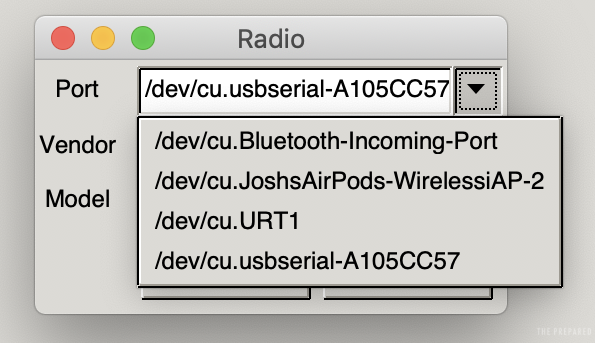
It might take some trial and error to pick the correct port from the list of poorly-labeled options — but don't worry, you can't harm annihilation, and you lot'll know if it fails considering CHIRP won't exist able to talk to your radio.
You should showtime look for a port with USB somewhere in the name. Click download. If the process fails, try another port.
One time you've done this footstep, yous shouldn't accept to go through it once more on the same computer.
Motility through all the prompts and warnings that appear. Don't exist likewise nervous about the warnings. In our tests, the warnings told the states that the driver was experimental and there weren't whatsoever guarantees about whether it would work. (These are common warnings in this kind of community-driven software.)
If everything works every bit it should, yous'll run into a dialog box that indicates cloning has begun. CHIRP is now copying frequencies from your radio to the CHIRP system.
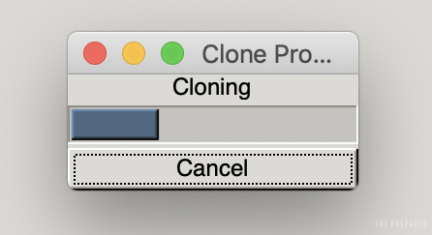
After a few seconds, a table will appear listing the frequencies programmed into your radio.
Problem? Just start the procedure once more. In our experience, bug pop up in the initial handshake between the estimator and radio. Once you're by this point, it tends to be shine sailing.
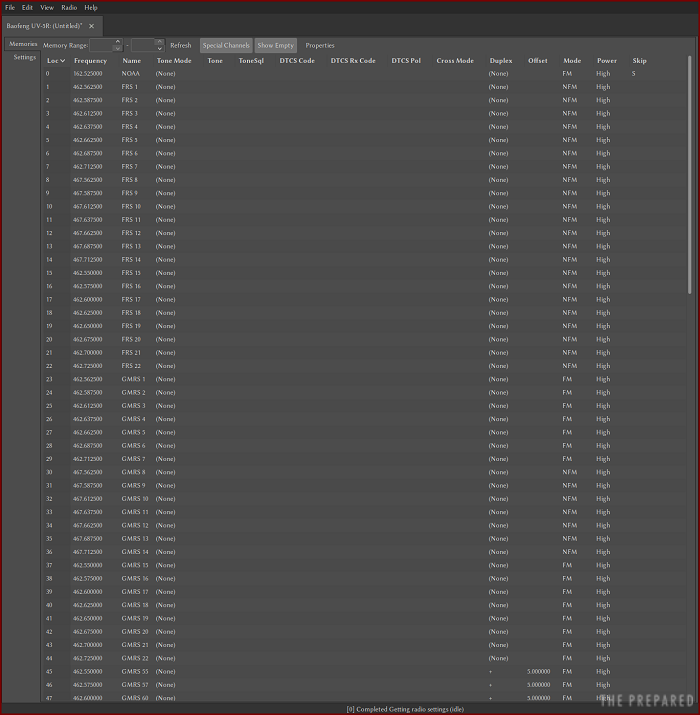
CHIRP's interface uses tabs. When yous download your radio's frequency list (shown in a higher place), all of that info will appear under one tab (chosen "Memory" in the screenshot). It's possible you lot finish upward with multiple tabs, and so just exist enlightened.
Within each tab, radio frequencies appear in a tabular array. Experienced Hams should recognize many of these settings, but a few key columns require an explanation for beginners:
- Loc: The channel number assigned to each frequency. Loc 0 will be Channel 0 on your radio, Loc x will be Channel 10, etc. Notation that your radio only has so many bachelor channels you tin can program. For instance, the BaoFeng UV5RV2+ tin can have 128 total channels programmed into it.
- Frequency: The bodily frequency assigned to each channel.
- Proper name: A label you lot'll assign to each channel. You lot're restricted to but a handful of characters, so each i needs to count. Utilize a repeater callsign, like KY4BG; a nickname, similar 2M CALL; or a standard channel name for a frequency, like FRS 1.
- Duplex: Lets yous dabble with manual settings, and is a whole topic in and of itself. Put simply, if you set Duplex to Off, you won't be able to transmit to that channel. You lot'll probably want to turn Duplex to Off for weather stations and emergency response frequencies similar police force and fire.
- Skip: Setting Skip to S volition get in and so that the radio will automatically skip over that frequency when scanning. Enable Skip for any atmospheric condition stations you program in since they're always broadcasting.
It's adept do to first make a backup whenever you lot are going to brand changes to your radio.
Cull File > Save, give your image a memorable proper noun (such equally today'due south date + "fill-in"), choose where to salve the file, and click Save.
Images vs exports
What you just saved is an "image" of your radio. Information technology's a moment-in-time snapshot of everything digital stored on that radio — non only the address volume — such as your general settings.
That's helpful for cloning all of the setup info across other radios of the same model. For case, if yous lose your radio just replace it with the same model, you lot just use that epitome file and everything about the new radio volition be similar the old 1. But those images are specific to the radio model since they touch things like radio-specific settings.
Saving only your address book is slightly dissimilar. Information technology doesn't include the radio-specific settings, just the contact info table, which means you can upload the accost volume to whatsoever radio. That comes in handy when you lot take multiple models in your family or prepper group.
Those address-book-only backups are explained in the last section.
Importing basic frequencies
One of the large advantages of CHIRP is the built-in directory of common frequencies. You lot could use CHIRP to manually enter your address book, just that's still tedious and error decumbent.
At that place are a few carte du jour items for importing frequency presets. Radio > Import From Stock Config is a good place to start, every bit this card item offers mutual universal frequencies to import. Here you lot'll find US calling frequencies, NOAA weather stations, and Us FRS and GRMS frequencies.
From Import From Stock Config, select US Calling Frequencies to import the Ham calling frequencies outlined in the American Radio Relay League's band program.
Across the entire radio spectrum, nearly preppers end upward using frequencies in just two chunks of the spectrum: 2m and 70cm.
But if you are simply trying to telephone call out into the void looking for random connections, which specific frequency would you apply? The radio community has set informal standards, such every bit "calling frequencies" that are kind of a general-purpose chat room. Those are some of the frequencies you'd dial into to try and reach random people in an emergency.
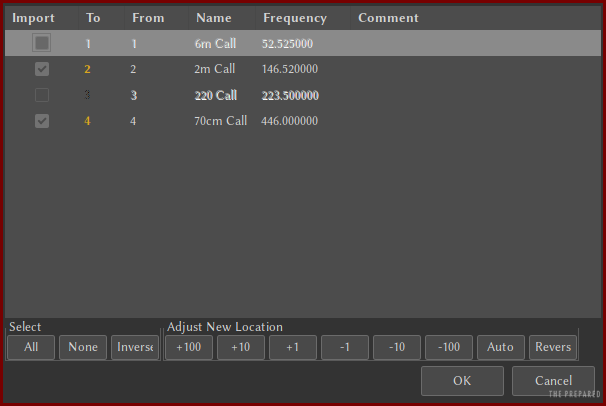
In the above dialog example, you'll notice that the first column, Import, is checked only for the second and fourth entries. That'due south because the BaoFeng UV5RV2+ radio in our demonstration merely supports the 2m and 70cm bands (ie. VHF and UHF). CHIRP volition not import frequencies your radio tin can't handle.
Next, look at the To cavalcade. That's the aqueduct number CHIRP will assign to your address book, ie. where it is sending that imported entry to. In the higher up example, channel 2 is the 2m Call, and aqueduct four is the 70cm Phone call.
Change the automated channel settings
The automatic channel settings CHIRP assigns to each frequency aren't optimal. In the above case, CHIRP would create channels two and four but skip over channels zero, one, and three. Even if we started from a totally-blank address book and didn't have to worry about conflicts, that ordering might be frustrating.
To fix the channel numbers, wait to the lesser of the dialog under Conform New Location. If you click Car, CHIRP volition gear up the 2m Phone call channel to channel zip and 70cm Phone call to channel one.
Alternatively, you lot tin double-click the number for the channel under the To column to set information technology manually.
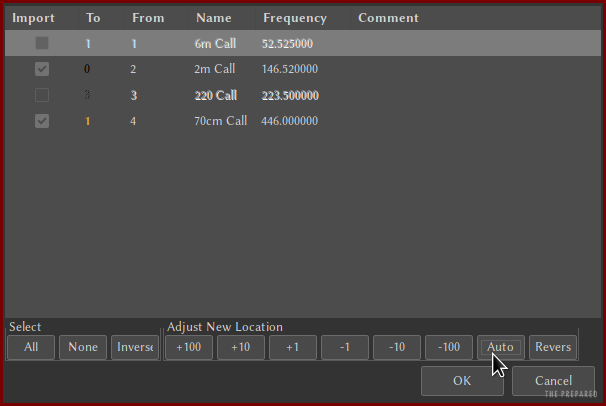
The advantage of using the buttons under Adjust New Location is that information technology will update all the channel assignments in one go.
You lot but want to use Auto for the starting time frequencies y'all import into a blank accost book. You'll use the numbered buttons (+1, +ten, +100) below Arrange New Location the next time you import, so that the next import starts where the current accost book ends, or further down if you lot desire to go out some channels empty.
Check each aqueduct manually to avoid overwriting the channels you've already prepare.
A simple case:
- You lot already have Channels 1-8 saved and don't want to mess with them.
- Yous then get to import a batch of fourteen frequencies, such as the atmospheric condition examples below.
- If you don't manually intervene, CHIRP might place those 14 new frequencies in Channels 1-14.
- But since 1-8 are already taken, you demand to tell CHIRP to import the new batch starting with Channel nine in the "To" field.
Calculation conditions stations
To add weather condition frequencies, use the aforementioned process: Radio > Import From Stock Config > NOAA Weather condition Alert.
For weather channels, two configurations are important:
- Unless you're a meteorologist, you won't want to transmit to weather condition frequencies. So make sure Duplex is Off on all of your weather frequencies.
- Tell your radio to skip scanning those stations by putting Southward in the Skip column. If you leave them equally-is and gear up your radio to scan, information technology's going to terminate at every weather condition station your radio tin selection up. And since the atmospheric condition stations are always dissemination, your scan will get stuck there.
Problem? If yous accidentally set up Skip on the wrong station, click the South and choose the blank gray block above the S. This will turn off Skip for that aqueduct.

Adding local repeaters
CHIRP is especially handy for entering Ham radio repeaters. A repeater is a detail Ham radio station, usually on a tall loma or mountain, that listens for signals so "repeats" them out over a wider expanse. Many repeaters crave special settings, such as a frequency get-go (since they usually heed on one frequency and transmit on another) and a PL tone. Not only does CHIRP let y'all enter frequencies, offsets, and PL tones manually, only it can straight import frequencies from popular online repositories to make programming a snap.
To connect to the repeaters around you, choose Radio > Import From Information Source > RepeaterBook > RepeaterBook Proximity Query.
That brings upward a dialog where you'll enter your Cypher Code, search distance in miles, and available bands. To maximize the number of repeaters CHIRP finds, keep Band set to All. CHIRP won't import frequencies incompatible with your radio.
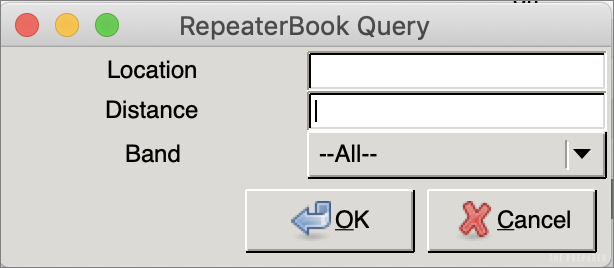
It's tempting to brand a really wide search area. But you lot don't want to clutter your address book to the point information technology's unhelpful. You lot might consider the distance between your work and dwelling, how far apart core family members might be on a typical day, how far you'll travel to a bug out location, etc.
You might notice that the Ham repeaters take some extra settings in the columns, such as tone and offset. These are crucial for being able to transmit to the repeater.
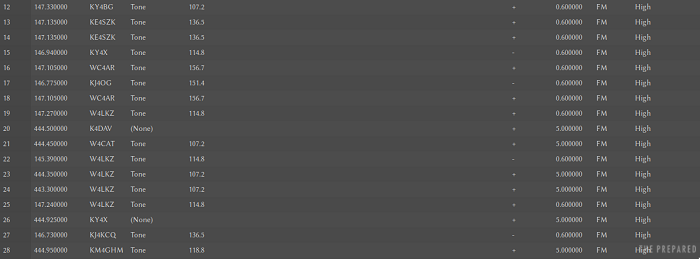
Adding emergency and offset responder frequencies
There are two types in this bucket:
- Standard frequencies that people can use to call for help. Think of it similar dialing 911 — information technology doesn't thing where you are in the US, you can telephone call 911 and get assistance. Similarly, virtually boaters know that Channel sixteen is the universal call-for-help channel on marine radios.
- The specific frequencies used by your local responders, such as constabulary and fire.
Wikipedia lists several international distress frequencies that are expert to know and have programmed in your radio. Here are just a few:
- 2-meter calling frequency is 146.520 in the Americas, 145.5 in Europe, and 145 MHz in the Philippines, Indonesia, and Thailand.
- 70-centimeter calling frequency is 446 in the Americas and Asia, 433.5 in Europe.
- Marine VHF channel 16 (156.8 MHz), which you can import into CHIRP in Radio > Import from Stock Config.
- FRS channels ane, 3, and twenty. Coil downward the page to learn how to program FRS and GRMS channels with CHIRP.
The prepping customs has made various attempts to create their own agreed-upon universal channels. Nosotros'll cover that in a separate guide.
Programming your local first responder frequencies can get complicated. Y'all tin practice it manually by scanning until you find what's agile in your area. You can manually browse websites similar RadioReference and copy-paste the info over. Or y'all could call a local radio group or even the police/whatever directly and enquire.
At that place are databases with this info that can be imported directly into CHIRP, namely from RadioReference com, but you must have a registered account and purchase a premium subscription to import those frequencies direct.
Some people using CHIRP on Linux and macOS encounter an mistake here about a "missing Suds package." Steps to fix are at the end of this department.
Tip: You can test that the RadioReference import/connection will work before you pony upwardly the cash. To test it out, choose Radio > Import From Information Source > RadioReference.com. At the dialog that prompts you lot for your username, password, and Goose egg Code, just put in gibberish and click OK. If you get an error that your username or countersign is invalid, y'all're all fix. Feel costless to sign upwards with RadioReference.com and continue with the import.
Assuming the import connection is fine, choose Radio > Import From Data Source > RadioReference.com. Input your real username, password, and Zero Lawmaking.
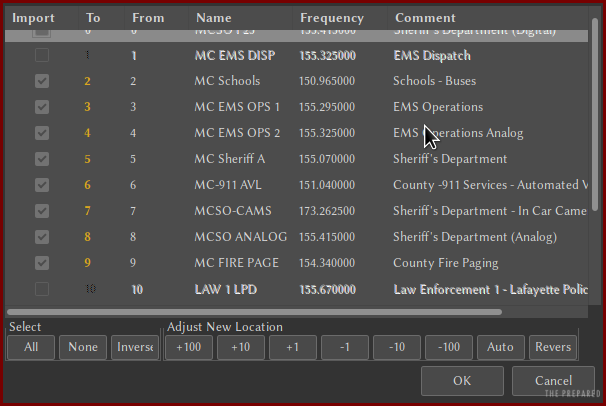
Just as with the other import types, yous'll run into a list of frequencies to import. Utilize the bank check boxes on the left (under "Import") to decide which ones yous want to bring in.
You'll be in a globe of hurt if y'all transmit on official responder frequencies without a bona fide emergency. Maybe your child grabs a radio and decides to play cops and robbers. To prevent outbound transmissions, set the Duplex column to Off.
Fixing the Suds package: a brief detour into Python hell
Skip this if yous haven't received an error only about Suds.
Python is a programming language. The current version is 3, simply CHIRP is still based on version 2, which is discontinued. That makes it a fiddling tricky to fix, considering if you lot install the electric current version of Suds meant for Python 3, information technology won't work.
macOS
Open the Terminal in /Applications/Utilities and enter:
sudo easy_install -z suds
This set up works in both macOS 10.fourteen Mojave and 10.15 Catalina.
Linux
Things are a bit dicier on Linux since every distro is dissimilar. The higher up command might work, merely information technology didn't on the ThinkPad we used. In Arch Linux, these commands could work:
sudo pacman -Due south python2-pip
pip2 install suds
pip is a package manager for Python modules. As yous might have guessed, there's a version for Python 2 and i for Python three. The above commands use Pacman, Arch Linux's bundle director, to install the Python 2 version of pip and so invoke it to install Suds. Check your distro's bundle managing director for the Python ii version of pip and and so run the second control to a higher place.
You may observe that to be more than trouble than it's worth, and instead opt to copy the data from the RadioReference website and paste it into CHIRP, which will toll y'all nothing. That'southward off-white, only it'southward besides a tedious, error-prone process. Yous'll take to individually copy each frequency, proper noun, PL tone, etc.
You could also export a CSV file of frequencies from the RadioReference website and import it into CHIRP, but that's no less hard than a directly import into CHIRP. RadioReference.com doesn't export a CSV file formatted how CHIRP expects.
Adding FRS and GRMS
This role is like shooting fish in a barrel, simply you may non want to do it. As explained in the intro to Ham radio, Family Radio Service (FRS) and General Mobile Radio Service (GMRS) are special non-Ham bands. FRS is essentially meant for walkie-talkies. GMRS is a souped-upwardly version of FRS that requires a license.
Bottom line: FRS and GMRS are for purpose-congenital radios. Transmitting on those frequencies from a normal Ham radio is technically illegal. Still, in an emergency, you may want to take as many frequencies bachelor to yous as possible, and the FCC rules let you transmit on whatever frequency in the upshot of a life-or-decease-emergency. A Ham operator might not be nearby, merely in that location might exist someone with an FRS walkie talkie or a GRMS radio you tin can achieve. Also, it's good to accept these frequencies on your radio to browse through just in case someone calls from these frequencies for assistance.
Cull Radio > Import From Stock Config > US FRS and GMRS Channels.
Just as with the others, y'all're presented with a list of frequencies. This fourth dimension, all of them should piece of work with your radio. Every bit always, you lot'll demand to adapt the aqueduct numbers.
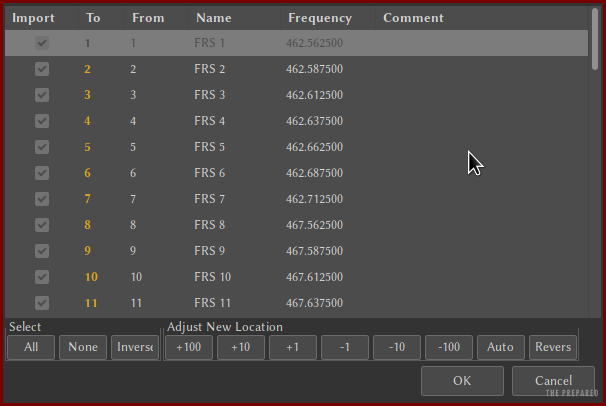
If you accept empty channels left over, you tin can add more if you similar, such equally marine bands or MURS channels.
Irresolute general radio settings
You can besides adjust many of your radio's settings in CHIRP. We tin't embrace all settings since some settings depend on the model of your radio. When in doubt, don't change stuff.
Wait for the Settings tab. To return to viewing your channel list, click Memories, just above the Settings tab.
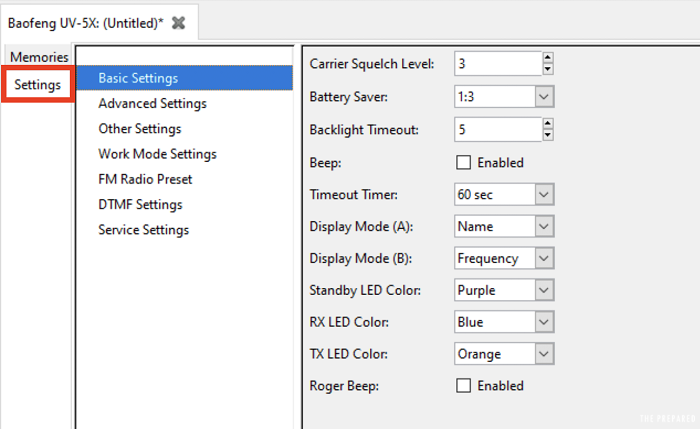
An example customization some people like to make through these settings is how the aqueduct labels are displayed on the screen. You could display the man-friendly name (eg. "2M Call") or the frequency. Instead of having both rows using the same labeling scheme, you tin can fix one row to utilise one method and the other row to use a unlike 1.
Many radios, similar the pictured BaoFeng, can tune into two channels at once that you quickly flip back and along between. It's similar to how many TV remotes accept a button that flips between your two virtually-contempo channels. In the movie beneath, the two primary lines shown on the screen are the two channels currently active. You can run across the channel number on the correct (in this case both are prepare to Ch 0), and the blueish "A/B" button by the thumb is what flips between the two. The upwardly arrow past the "2M" shows which one is currently active. If the bottom row were agile, the arrow would be past the "146".
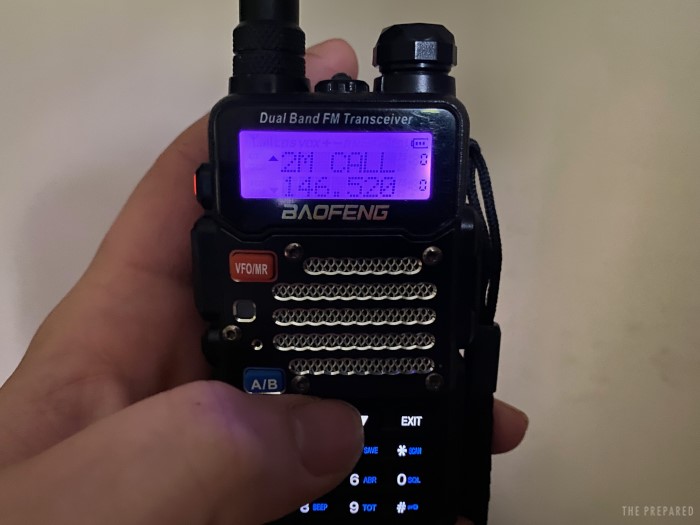
Imagine you lot're in an emergency and you're flipping through your address volume via the pinnacle row on the screen. You're seeing labels like "2M Phone call", "FIRE DEPT", etc curl by. You somewhen find the one you lot want.
Just your buddy also wants to dial into the same frequency, except she doesn't accept the same address book on her device that you do. If you lot only have your radio, it would be hard to contrary-engineer or dorsum-out what the frequency is for "2M Telephone call" that your friend would and then punch into their radio.
By having the second row programmed to prove the frequency instead of the human being label, you could then pull upwards the same aqueduct (Channel 0 in this case) in the second row, but this time it shows the numbers your friend tin re-create.
Saving changes to the radio
Once you're satisfied with your aqueduct list, you're set up to upload it to your radio. If you unplugged your radio, you'll want to plough it back on, creepo up the volume, plow to a silent station, and plug it back in.
Make a backup of your work by saving the channel listing to your calculator using the same steps from before.
Choose Radio > Upload to Radio. At this bespeak, you should have your port, vendor, and model set correctly. Click OK and click through any prompts to clone your new channel list to your radio.
Sharing your address book with others or changing radio models
When you make a backup of your radio'south "prototype", it saves the info in an actual IMG file that's specific to your radio because it includes both the accost book and the custom/general settings specific to your model.
Since you can't just import that IMG file to a different radio model (such equally moving from a BaoFeng UV-5R to a BF-F8), that means you have to do an intermediary step if you lot want to utilize the data to a new model or share your frequency list with people who take different radios.
To open a radio prototype, choose File > Open and choose it from the directory.
To consign your radio'due south frequencies, choose File > Export.
The exported file will exist in CSV format, a standard format for spreadsheets. You tin then import those frequencies to another radio model past opening your new radio'south image and choosing File > Import. Select the CSV file you exported.
Exporting to CSV is handy for syncing frequencies between different radio models. However, if you maintain multiple configurations for a single radio, it'south easier merely to save them as images. You can make multiple images for your radio and switch betwixt them. For instance, yous might accept a ready of frequencies to scan at dwelling and another fix while yous're on vacation.
Source: https://theprepared.com/gear/guides/program-ham-radio-chirp-software/
0 Response to "How to Upload to Radio With Chirp"
Postar um comentário